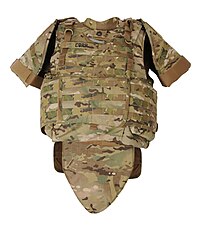
Photo from wikipedia
Treating Kevlar fabric with silica nanoparticles is known to augment its mechanical properties, especially under shear deformation. Silica nanoparticle-treated Kevlar (SNK) fabric could therefore display improved ballistic performance. In this… Click to show full abstract
Treating Kevlar fabric with silica nanoparticles is known to augment its mechanical properties, especially under shear deformation. Silica nanoparticle-treated Kevlar (SNK) fabric could therefore display improved ballistic performance. In this study, the ballistic performance of SNK with various percentages by weight of nanoparticle addition and number of layers is evaluated using compressed air gun experiments. A colloid-based treatment procedure is used to impregnate dry silica nanoparticles into the fabric. Addition of nanoparticles provided about 17.3% mass advantage (due to three fewer layers) for the 40 wt.% SNK vis-à-vis neat Kevlar for the non-penetrative case. SEM imaging reveals that at higher treatment levels the nanoparticles tend to agglomerate in the interstitial spaces of yarn crossover points, which helps better engage secondary yarns away from the impact location of the projectile. A semi-empirical model is developed to capture the influence of treatment level and number of layers on the kinetic energy absorbed by SNK. The flexibility of SNK is tested using a fixed cantilever test that avoids the sliding of the sample between flat plates used in standardized tests, which tends to dislodge the nanoparticles. The measured tip deflection angle decreases from 33o for the neat fabric to 19o for the 40 wt.% SNK. The flexural rigidities educed using digital image analysis range from 48.9 μNm2 for the neat fabric to 113.7 μNm2 for the 40 wt.% case. SNK could potentially enable multifunctional structural solutions in applications related to personal protective gear, military vehicle hulls and impact shielding of space structures.
Journal Title: Journal of Composite Materials
Year Published: 2022
Link to full text (if available)
Share on Social Media: Sign Up to like & get
recommendations!